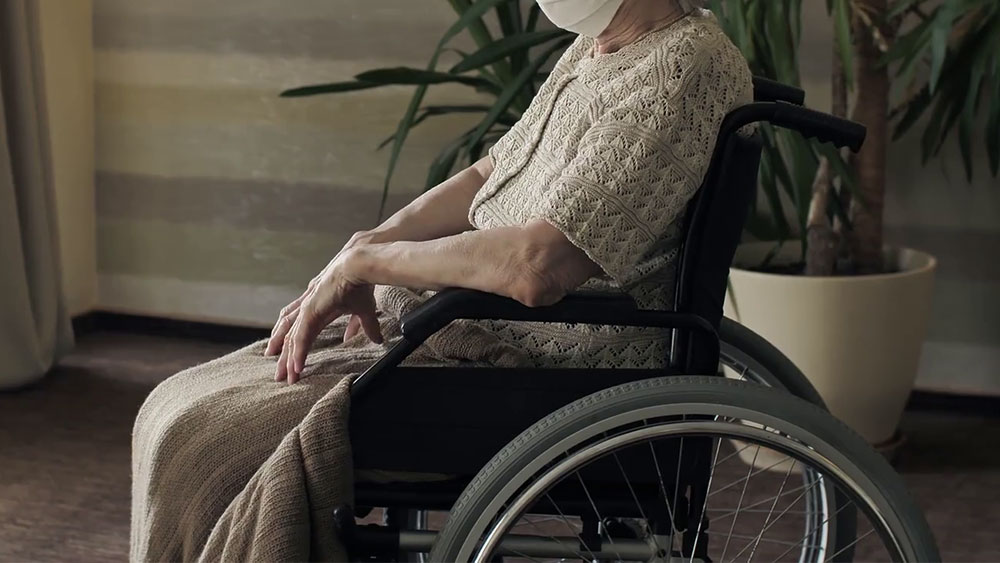Table of contents
- What precautions should the patient take?
- Before leaving the room
- What precautions should the caregiver take when Management of the Covid 19 patient at home?
- When accessing or contacting the patient’s room, ask to wear your mask
- If the patient has their own bathroom in the room:
- If the patient does not have their own bathroom in the room:
- If an older adult has to live with a Covid 19 patient at home, the caregiver must:
- Management of the Covid 19 patient at home
The management of the Covid 19 patient at home requires certain knowledge that is essential to feel safe and avoid contagion within the family unit. Here are the guidelines that every professional care or family in charge should know. You must remember that with regards to the management of the Covid 19 patient at home, you should always exclude risk groups: people over 65, hypertensive patients, people with COPD, diabetics and people with heart disease.
What precautions should the patient take?
You want to confine yourself to one room (preferably with its own bathroom) with the windows open (if it is cold, you can close so that there is no current or they will open them several times a day)
When you leave the room, you should notify the caregiver through Whatsapp and let them know what you want to do. You will only leave when the caregiver gives you the OK. If the exit is avoidable, avoid it.
Throw all your waste (tissues, etc.) in a trash can in your room with a garbage bag inside.
If the sick person leaves during the caregiver’s absence, he/she must inform the caregiver of the itinerary followed (I have been in the kitchen) and must be very strict.
When the sick person leaves the room, the caregiver must observe from a distance (at least 1.5 meters):
Before leaving the room
Before leaving, you should wash your hands with disinfectant and try not to touch your mucous membranes after washing (Mucous membranes include eyes, mouth, anus, vagina, penis) or any discharge of your own.
Mucus
Feces
Saliva
Urine
You must wear a mask, or if you don’t have a nose and mouth cover made of a dense cloth.
Also, you should cough and sneeze into your mouth with the back of your elbow.
Furthermore, you should try not to touch knobs, switches, any surface that is susceptible to being touched by another (try doing it with your elbows, etc)
You must notify the caregiver so that they can take appropriate action:
Follow your steps and clean with water and bleach all surfaces that may have been touched (doorknobs, switches, refrigerator handle, drawer handles) and ALL HORIZONTAL SURFACES that may have been exposed to droplets from coughing or sneezing (countertops, horizontal surfaces of sinks, bidet, bathtub, etc.).
Open the windows of the room through which the patient has passed so that it is properly ventilated for at least half an hour.
What precautions should the caregiver take when Management of the Covid 19 patient at home?
To have hydroalcoholic gel for hand disinfection. One precaution is to wash your hands with the gel every 30 minutes while you are doing activities at home.
Prepare a daily water and bleach mixture, as explained below, in a bowl or bucket. You need to replenish this mixture every morning by throwing away any leftovers from the previous day (remember that this mixture will leave discoloration stains on dark fabrics, do not use on clothes, but it is very practical for living with Covid 19 at home):
One and a half liters of water (A normal bottle of water)
6 tablespoons of lye (One quarter of a normal glass)
Wear gloves during all cleanings and when in contact with the patient. Do not wear bracelets, rings or watches while in the house.
You can “sanitize” the mask by spraying it with water and bleach with a spray. A spray from a cleaning can can be reused after it has been thoroughly washed inside. This is so that no residue of the previous product remains (it can trigger a chemical reaction with the lye)
When accessing or contacting the patient’s room, ask to wear your mask
You also need to use a disposable protective gown, which can be made from a garbage bag with holes for the head and arms. It is important that the caregiver’s clothes do not come into contact with the sick person. It is better that the naked arms appear outside of the bibs. This is because you want to wash with soap and water since the virus cannot spread through the skin.
When washing the sick person’s clothes, do it with a washing machine at 60º. It is important that the sick person wear clothes that can withstand such temperatures so that they do not get damaged.
All garbage from the sick person should be thrown in a trash can with a garbage bag. This bin should have a cover(pedal bin) and the bin should be in the patient’s room.
Dishes, knives, forks, glasses, etc. They should be washed in the dishwasher or with water above 56° and detergent. Or, with water and bleach if hot water is not available.
After each contact with the patient, upon arrival from the street and before leaving, before and after taking off the gloves, you should wash your hands.
If the patient has their own bathroom in the room:
If this situation occurs, the handling of the Covid 19 patient at home is much easier and the risks are less.
Clean the patient’s room and bathroom once a day (only if the patient has his own bathroom). In this case the following precautions should be observed:
Always use gloves.
If the room has a bathroom:
The patient will wait inside the bathroom until the caregiver finishes cleaning the room.
When the caregiver is cleaning the bathroom, the patient should wait in the room more than one and a half meters away from the caregiver or sitting on the bed with his/her back to the room. You can also take him/her out to a common but well-defined area (an armchair in the living room). You will have to clean afterwards next to the surfaces that may have been exposed.
In the room, you should clean all horizontal surfaces (bedside tables, shelves) with a solution of water and bleach
The same is true in the bathroom (sinks, bidet, bathtub, etc.). You can use pure bleach with caution in the WC and wash basin.
If the patient does not have their own bathroom in the room:
Sometimes it is necessary to share the bathroom. This situation makes it more difficult to live with Covid 19 at home but with the following precautions there should be no problems.
Clean the room once a day.
Always use gloves.
When cleaning the room, the patient should remain more than 1.5 meters away from the caregiver or sitting on the bed with his/her back to the room.
You should clean all horizontal surfaces (bedside tables, shelves) in the room with a solution of water and bleach.
Also, you must clean the bathroom automatically after each use all horizontal surfaces (basins, bidet, bathtub). You can use pure bleach with caution in the WC and wash basin.
If an older adult or a person at risk lives on the floor of the Covid 19 infected person
If an older adult has to live with a Covid 19 patient at home, the caregiver must:
Coordinate the movements of the sick person and older adult so that they do not coincide at any time in the same room.
Maintain all of the above precautions so that the older person does not come into contact with anything that the sick person might have touched without disenfecting first.
In the case of contact, wash the hands of the older adult: WE WILL NEVER CONSENT TO OLDER ADULT TOUCHING MUCH STUFF AFTER CONTACT WITH CONTAMINATED SURFACE
The caregiver should wear a mask when in contact with the older person in case he or she has become infected.
Management of the Covid 19 patient at home
Living with Covid 19 at home can generate a lot of stress but having quality information helps to be more relaxed. The advice we give you in our blog is supported by the WHO, the ministry and our own health advisors.
We hope that these tips from Nomenial will be useful for you to live with Covid 19 at home.
For more tips on how to manage covid 19 at home please visit this link.







